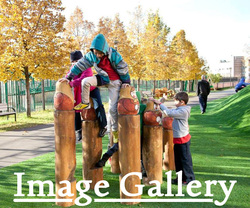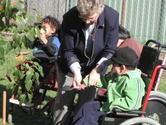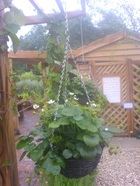Wellness gardens
Sensory gardens and wellness gardens for children and adults with special educational needs
Social and therapeutic horticulture is catered for with rehab gardens in hospitals and care homes. Elements of every design include walkways within the garden structure, providing places for gathering and solitude, for working and resting, for visiting and observing, and playing and learning … all designed to support the well-being of garden users.
In a mixed use wellness garden, it is good to incorporate a children’s area with natural play and equipment, sensory garden and place for families to gather. “Through the use of perimeter planting walls and planters, a vine-draped trellis, raised camomile lawn, a butterfly garden, as well as plantings and ornamental fencing it is possible to create a secure area with active and quiet zones,” says specialist schools landscape designer Gayle Souter-Brown.
If space allows, a waterfall garden and pebble stream brings wonder to the garden.“This part of the garden is a safe area to explore, play and rest. Surrounding it by sweeping drifts of ornamental grasses and a small grove of ornamental shrubs would give a sense of enclosure,” says Souter-Brown.
Rainwater harvesting and bio-diverse planting to attract wildlife brings a sustainable sensory garden within reach. To fully engage our senses we need to reconnect with nature.
Gardens for disabled users include overhead shade pergolas, large planters with ornamental trees, and raised beds for vegetables and herbs to keep the interest of wheelchair users and walkers alike. A working garden of raised beds and containers, and an area with planters and outdoor furniture for group activities would complete the space.
Seasonal interest and variety throughout the year are important. “It is good to create multiple sensory-stimulation environments, with plants selected for fragrance, texture, and colour, in a sequence of colour from spring to summer, summer to autumn, autumn to winter, and back to spring."
In a mixed use wellness garden, it is good to incorporate a children’s area with natural play and equipment, sensory garden and place for families to gather. “Through the use of perimeter planting walls and planters, a vine-draped trellis, raised camomile lawn, a butterfly garden, as well as plantings and ornamental fencing it is possible to create a secure area with active and quiet zones,” says specialist schools landscape designer Gayle Souter-Brown.
If space allows, a waterfall garden and pebble stream brings wonder to the garden.“This part of the garden is a safe area to explore, play and rest. Surrounding it by sweeping drifts of ornamental grasses and a small grove of ornamental shrubs would give a sense of enclosure,” says Souter-Brown.
Rainwater harvesting and bio-diverse planting to attract wildlife brings a sustainable sensory garden within reach. To fully engage our senses we need to reconnect with nature.
Gardens for disabled users include overhead shade pergolas, large planters with ornamental trees, and raised beds for vegetables and herbs to keep the interest of wheelchair users and walkers alike. A working garden of raised beds and containers, and an area with planters and outdoor furniture for group activities would complete the space.
Seasonal interest and variety throughout the year are important. “It is good to create multiple sensory-stimulation environments, with plants selected for fragrance, texture, and colour, in a sequence of colour from spring to summer, summer to autumn, autumn to winter, and back to spring."
|
Greenstone Design Limited is a company registered in New Zealand No 373 2566 Registered Office: 384 Minchins Rd, Sheffield, NZ 7580. GST registration No 108 766 034 |
Corporate Social Responsibility | Diversity & Equality | Environment al Policy
Quality Management Statement
© Greenstone Design Limited 2001-2023 All rights Reserved




